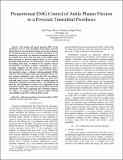| dc.contributor.author | Wang, Jing | |
| dc.contributor.author | Kannape, Oliver Alan | |
| dc.contributor.author | Herr, Hugh M | |
| dc.date.accessioned | 2013-08-22T18:55:46Z | |
| dc.date.available | 2013-08-22T18:55:46Z | |
| dc.date.issued | 2013 | |
| dc.identifier.uri | http://hdl.handle.net/1721.1/80165 | |
| dc.description.abstract | The human calf muscle generates 80% of the mechanical work to walk throughout stance-phase, powered plantar flexion. Powered plantar flexion is not only important for walking energetics, but also to minimize the impact on the leading leg at heel-strike. For unilateral transtibial amputees, it has recently been shown that knee load on the leading, intact limb decreases as powered plantar flexion in the trailing prosthetic ankle increases. Not surprisingly, excessive loads on the leading, intact knee are believed to be causative of knee osteoarthritis, a leading secondary impairment in lowerextremity amputees. In this study, we hypothesize that a transtibial amputee can learn how to control a powered anklefoot prosthesis using a volitional electromyographic (EMG) control to directly modulate ankle powered plantar flexion. We here present preliminary data, and find that an amputee participant is able to modulate toe-off angle, net ankle work and peak power across a broad range of walking speeds by volitionally modulating calf EMG activity. The modulation of these key gait parameters is shown to be comparable to the dynamical response of the same powered prosthesis controlled intrinsically (No EMG), suggesting that transtibial amputees can achieve an adequate level of powered plantar flexion controllability using direct volitional EMG control. | en_US |
| dc.description.sponsorship | United States. Dept. of Defense (award number 6920559) | en_US |
| dc.description.sponsorship | United States. Dept. of Defense (award number 6920877) | en_US |
| dc.description.sponsorship | Swiss National Science Foundation (grant PBELP3_140656) | en_US |
| dc.language.iso | en_US | |
| dc.rights | Creative Commons Attribution-Noncommercial-Share Alike 3.0 | en_US |
| dc.rights.uri | http://creativecommons.org/licenses/by-nc-sa/3.0/ | en_US |
| dc.source | MIT Web Domain | en_US |
| dc.title | Proportional EMG Control of Ankle Plantar Flexion in a Powered Transtibial Prosthesis | en_US |
| dc.type | Article | en_US |
| dc.identifier.citation | Wang, Jing, Oliver A Kannape, and Hugh M Herr. "Proportional EMG Control of Ankle Plantar Flexion in a Powered Transtibial Prosthesis." | en_US |
| dc.contributor.department | Massachusetts Institute of Technology. Media Laboratory | en_US |
| dc.contributor.department | Program in Media Arts and Sciences (Massachusetts Institute of Technology) | en_US |
| dc.contributor.mitauthor | Kannape, Oliver Alan | en_US |
| dc.contributor.mitauthor | Wang, Jing | en_US |
| dc.contributor.mitauthor | Herr, Hugh M. | en_US |
| dc.eprint.version | Author's final manuscript | en_US |
| dc.type.uri | http://purl.org/eprint/type/ConferencePaper | en_US |
| eprint.status | http://purl.org/eprint/status/PeerReviewed | en_US |
| dspace.orderedauthors | Wang, Jing; Kannape, Oliver A.; Herr, Hugh M. | en_US |
| dc.identifier.orcid | https://orcid.org/0000-0003-3169-1011 | |
| mit.license | OPEN_ACCESS_POLICY | en_US |
| mit.metadata.status | Complete | |
